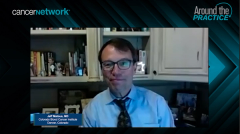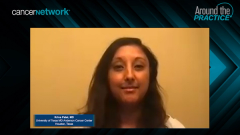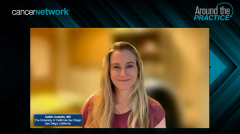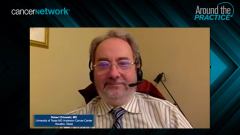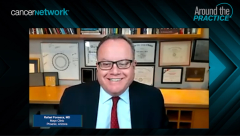
Outcomes with Daratumumab in Frontline Versus Subsequent Lines of Therapy in Transplant-Ineligible MM
A look at the patient outcomes with daratumumab use in the frontline vs second-line setting in patients with transplant-ineligible multiple myeloma, and the pros and cons of subcutaneous vs intravenous daratumumab.
Episodes in this series

Rafael Fonseca, MD: Dr Orlowski, what constitutes an adequate and successful response in patients who are transplant ineligible? Do you have the same expectations as with those who are eligible?
Robert Orlowski, MD: Adequate and successful could be 2 different definitions here. As for the transplant-eligible patients, the greater the cytoreduction, the better the long-term outcome will be. And certainly, trying to get into CR [complete response] and MRD [minimal residual disease] negativity is a valuable goal. But we balance that against the potential increased toxicity for these patients, so we try to make sure that we’re maintaining and hopefully even improving their quality of life and that their functional status is able to be maintained as well. There’s a greater focus on those clinical aspects rather than on just the M protein or free light chains.
Rafael Fonseca, MD: Let me ask you a follow-up question, because some of the audience may still have practices where they use intravenous [IV] daratumumab. I presume your practice has completely changed to subcutaneous. Could you share your experience with that? Is there any reason to stay with intravenous?
Robert Orlowski, MD: Definitely, the subcutaneous is better tolerated. There are fewer reactions to it. The time in the chair is decreased. There’s even a suggestion that the response is better. Part of that is because the 1800-mg flat dose, which is given as the subcutaneous injection, is oftentimes a larger dose than the 16 mg/kg that we use intravenously. It may just be that more drug is better. But I don’t know of any patient to whom I still give IV daratumumab.
Rafael Fonseca, MD: Excellent. I agree with that. In our practice, it’s not even a conversation for starting treatment. Jeff?
Jeff Matous, MD: I have 1 patient getting IV. She’s so tiny that she can’t handle the subcutaneous volume.
Rafael Fonseca, MD: That’s a good reason to do that. I have 1 patient who doesn’t want to change to subcutaneous, more than anything because they’re very comfortable with the IV. Dr Costello, do we bring MRD testing into this population? The MAIA trial showed 24% at 10-5 MRD negativity, and that also requires the testing for bone marrow. We’re all for the deepest responses possible, that goes without saying. But what about blood-based methods for MRD determination? Would that be applicable in this patient population?
Caitlin Costello, MD: Sure. The answer to your first question is maybe. When we’re talking about a transplant-ineligible population, for the most part, we’re talking about an older population. Realistically, then we’re talking about quality and quantity of life. If we’re trying to provide people with the best quality of life, sometimes that means we have to make some compromises in some places. I love to see the MRD data, but it’s not necessarily a practical approach for all older or transplant-ineligible patients to be able to push hard to get to that MRD state. I haven’t incorporated it into my practice for the majority of my older or any of my frailer patients because I wouldn’t change my practice according to it.
Rafael Fonseca, MD: Thank you. It’s fair to say we probably push more for MRD in the transplant-eligible patients. That’s not to say that’s proven to be the right way to go, but that’s what we’re doing right now. However, we’re very happy when we get into an MRD-negative status when a patient gets treated like this.
To conclude this section, I want to share that we presented a simulation in one of the oral sessions at ASH [American Society of Hematology annual meeting] using real-world analysis for the reasons that Jeff alluded to. We wanted to see if it made more sense to start with something like MAIA and then assume that if you relapse, the first relapse will be treated with carfilzomib or pomalidomide, or if you could start with something like RVd [lenalidomide, bortezomib, dexamethasone] and Rd [lenalidomide, dexamethasone] and then put something like POLLUX at your first relapse. One of the challenges is you want to have similar age categories, so we had to do this with real-world data. Because with studies like POLLUX, patients are 10 years younger and 60% of them have had a prior stem cell transplant, so it’s not apples to apples.
The other thing we did, which we have worked on and other groups have done even before, is the whole concept of attrition; the notion that with every line of therapy, there are some patients who aren’t going to progress for many reasons, including great outcomes but sometimes preference, or sometimes progression, death, or toxicity.
We did a sensitivity analysis putting that attrition in the middle, and we found that given that both regimens are supported by all guidelines—NCCN [National Comprehensive Cancer Network] and mSMART [Mayo Stratification for Myeloma and Risk-Adapted Therapy] both have the highest level of evidence with overall survival improvement—if we did that simulation, we found the median overall survival for starting with MAIA and then following with carfilzomib and pomalidomide was about 9.1 years, which was about 2 ½ years longer than if you started with RVd. Everyone wanted a head-to-head comparison of phase 3s. It’s the only way to have the conclusive answer to that. But given that both regimens are supported by all guidelines and they’re accepted as having a good level of evidence, this would be one way to think about the selection of that frontline therapy, and also in the absence of that neuropathy. Dr Orlowski?
Robert Orlowski, MD: I want to put in a shameless plug for an upcoming SWOG study that will look at the frail patient population. It’s a 3-arm trial, where 1 arm is RVd-lite for 9 cycles followed by R [lenalidomide] maintenance. A second arm is daratumumab, lenalidomide, dexamethasone [DRd] for 9 cycles followed by lenalidomide maintenance. The third arm is daratumumab, lenalidomide, dexamethasone for 9 cycles followed by lenalidomide and daratumumab [D] as maintenance. That will answer the RVd vs DRd induction question, and hopefully will tell us a little about whether R is enough as a maintenance in this population or whether R and D together are going to do better. That will hopefully be a very helpful study in terms of PFS [progression-free survival] and as you’re pointing out, overall survival.
Rafael Fonseca, MD: Thank you very much. We’ll wait to see those results with great interest.
Transcript edited for clarity.
Newsletter
Stay up to date on recent advances in the multidisciplinary approach to cancer.


